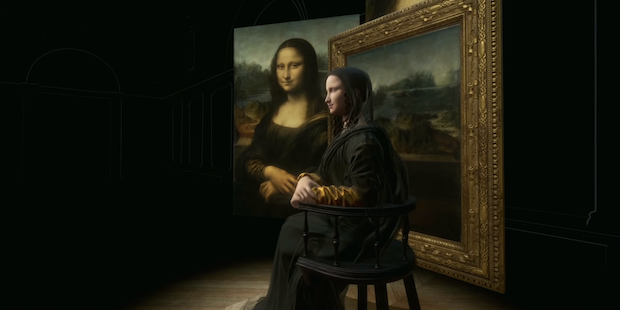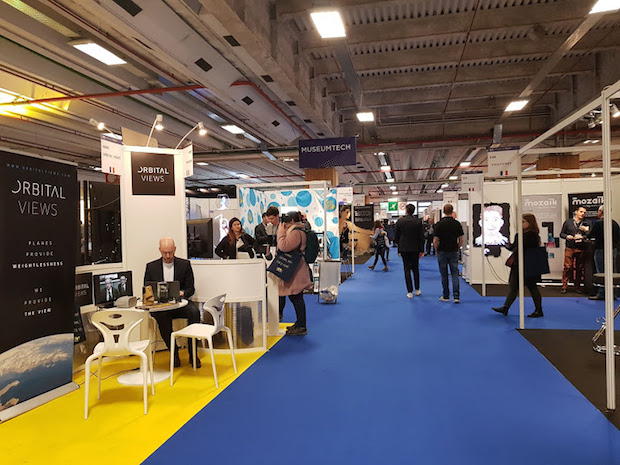Irina Grevtsova

Their doors closed due to the COVID-19 crisis, therefore museums and many cultural institutions have had to sharpen their wits in order to continue providing their visitors – now, virtual visitors – with high-quality initiatives.
Without wishing to ever replace the direct experience of a visit – to incentivize it rather, in what we hope will be the near future – technology makes it possible to shorten distances and make new approaches to cultural content and experiences available to everyone.
Sharing, participating and creating communally is made even more possible via audio-visual formats, the online dissemination of archives and collections, a host of digital resources, and information continually updated on websites and social networks.
The text of this week’s blog is a summary of this year’s edition of Museum Connections, an annual gathering that takes place in Paris, where the most cutting-edge digital technology used in the field of heritage is presented.
Editor’s note
Halfway through January this year, in a Paris immersed in transport strikes and demonstrations, the 25th anniversary of the Museum Connections Conference was held, a professional gathering bubbling over with creativity and production. The organizers managed to place 365 exhibitors in a large pavilion, present 53 international speakers and attract 3,510 visitors.
What format does Museum Connections have?
It is one of the most important meeting points in Europe, a place for inspiration and learning for museum staff, based on the analysis of real cases from very diverse sectors. It is also an event at which to do international networking and, of course, an opportunity to personally try out the latest technologies.
At the conference four main themes for the future were discussed, each one made up of different round tables:
- Theme 1. The future of museum communities
- Theme 2. The future of immersion in the museum
- Theme 3. The future of retail
- Theme 4. The future of mediation
The speeches were given in a hall called the ‘Inspiration Room’ and the sections took place at a very brisk pace. Between four and six experts took part in the round tables, each of whom had five minutes to present their project. The remaining time was devoted to discussions and each section lasted 45 minutes.
We shall focus on the analysis of technologies, without doubt the main driver of change in museums today.
Virtual Mona Lisa, 360º video projections, inclusive apps and open data accessible 4 all were the stars of this edition.

Theme 2. The future of immersion in the museum. Round table «Immersive experience. How it is shaking up the exhibition industry»
This section opened with the theme of immersive experiences in a packed hall. The experts invited represented museums, cultural organizations and private companies specializing in the film industry and festivals.
The projects presented had very diverse formats: 360° video projections on the walls of the Grand Palais building, the multimedia exhibition Leonardo: Experience a Masterpiece, or the Virtual Veronese project, a virtual tour of the painting The Consecration of Saint Nicholas. Projects were also presented such as a football media centre, film festivals and even some performed in shopping malls.

During the section different aspects of immersive exhibitions were tackled, but what this exhibition format means exactly was not defined. A digital or an analogue experience? Video mapping with 360º projections, visualized with or without displays? A virtual tour using VR goggles? This lack of a clear definition of what an immersive exhibition is was reflected in the different discussions, in which the speakers lost their way expressing different points of view about the costs and the ecological impact of production. I agree with what Roei Amit said, the director of the Technologies Department of the Grand Palais RMN in Paris, when he claimed that specialists do not currently have a clear perspective because we are in the middle of what is happening («We don’t have distance, we are in the middle»).
Theme 2. Round table «The Place of Human Interactions in VR Visits»
At the next round table, projects were presented by major French companies such as Emissive, Diversion cinema, and the Centre des Monuments Nationaux.
Emissive began designing its first cultural projects in 2012, when it initiated The Enemy, a virtual tour for 20 people, whose author is the journalist Karim Ben Khalifa. In the museums sector, its most important project is without a shadow of a doubt the VR experience Mona Lisa: Beyond the Glass, created for the Musée du Louvre. Lately, with the HIP Institute and Dassault Systèmes, they have designed Scan Pyramids VR, the immersive guided tour of the Pyramid of Khufu which takes place in a large hall in the Cité de l’Architecture et du Patrimoine in Paris. In this experience, the visitors use headphones and a VR backpack that allows them to move freely around the space and feel that they are inside the pyramid. The tour guide is a real person. Surprisingly, this virtual reality tour lasts 45 minutes, when a normal VR tour lasts no longer than 15 minutes.
VR experiences 1. Scan Pyramids VR Photo by Cité de l’Architecture & du Patrimoine / 2. Timescope of the Arc de Triomphe. Photo: Irina Grevtsova
Theme 2. Round table «Models for the funding and production of virtual reality in culture»
In this section highly topical issues for museums were dealt with, like ‘Which funding models can contribute to the implementation of technologies?’ According to Stephanie Targui, the French National Museum of Natural History in Paris had to seek sponsors and collaborated with the Orange Foundation in order to install the virtual reality hall. In this way the ticket prices made it possible to recoup the costs of the project in two years.

Another issue lay in how to obtain joint funding for temporary exhibitions, like, for example, the case of the exhibition Claude Monet, the Water Lily Obsession, held in the Musée de l’Orangerie. For it, the Musée d’Orsay collaborated with HTC.
Theme 3. Round table «What does creating inclusive mediation tools mean in 2020?»
This was devoted to mobile guides, an industry that is now well established. What concern the experts are not so much the quantitative indices and the spectacular nature of their projects, but rather quality and comfort in the use of technologies by the public. All the speeches placed special emphasis on how to make applications as inclusive and as easy to use as possible.
Jean-Pierre Charbol, of the Australian Museum of Contemporary Art, spoke about new projects in the field of augmented reality (AR). He claimed that by renouncing mobile applications and opting for the web browser, in which it is possible to open the guide directly without having to download the information on your mobile, access to it can easily be obtained. He also spoke about the intuitive form of access to information, with regard to objects, which augmented reality technologies give just by focusing on them with your telephone’s camera. The exhibition of the large-scale canvas created by the artist Guan Wei was also interesting.
In this section issues related to mobile tours for all kinds of people were also dealt with. In France the inclusiveness of a product can be certified, by obtaining the Tourisme & Handicap certificate. At the round table issues were discussed such as autonomy, the levels of the narration of history, evaluation and statistics, the legalization of products, the personalization of experiences, orientation and promotion, and many others.
Theme 3. Round table «Beyond access, participation strategies for open data»
This section was no less topical. In recent decades museums in Europe and all over the world have been digitizing their pieces and using open data programs. Once this stage has successfully been completed, new questions arise in the daily agenda: What to do with the billions of gigabytes of digitized cultural heritage? And how to teach users how to take advantage of this information?
The moderator of the section was Douglas McCarthy, the representative of Europeana, the largest digital heritage platform in Europe. The experts discussed the new strategies and possibilities for using co-creation, co-production and co-working methods.
What I found most eye-catching was the T-shirt with the image of a painting exhibited in the Museum of Slovakia and the remix for public transport. Michal Cudrnak, of the National Gallery of Slovenia (Slovenska narodna galeria), chose these cases to show the public the potential of work with digital collections in museums.
The creative use of open data digital collections in Slovakia. Photo: Irina Grevtsova
In this way, the issues that were the subject of discussion at this round table showed that the branch of the digitization of cultural heritage had come to its logical end: collections have been taken out of the hands of professionals and handed back to the people.
Museum Tech
As for Museum Tech, an area dedicated to exhibiting technologies, a wide range of interactive devices of all kinds was demonstrated, from mobile guide apps and screens of all sizes, to holograms and virtual and augmented reality. The majority of the producers were private companies from different sectors in France. This year the Start-Up Village, bringing together 33 companies, was launched for the first time.

Where else can technologies applied to culture be tried out?
Museum Connections is the starting point for getting to know the latest trends, but the streets of the capital, its emblematic monuments, its museums and even the metro also have to be explored.
To have immersive experiences, which do not need visualization technologies, we have to go to new digital art centres. France already has several in Paris, in Baux-de-Provence, and this year another one is opening in Bordeaux – the largest digital centre in the world – which will undoubtedly be a must to visit.











